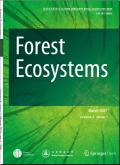The effect of Douglas-fir on biodiversity in European forests – What do we know and what do we not know?
IF 4.4
1区 农林科学
Q1 FORESTRY
引用次数: 0
Abstract
1. In recent years, climate change has led to drought and severe bark beetle infestations, affecting Norway spruce (Picea abies) across Europe, with detrimental consequences for forest owners, the forestry sector and associated industries. As a result, silviculture now faces the challenge of identifying tree species more resilient to these stressors to mitigate the impacts on forest management, forest-dependent economies and rural livelihoods. The North American Douglas-fir (Pseudotsuga menziesii) has emerged as a promising conifer species, better suited to future climate conditions and capable of producing high timber yields.
2. Non-native tree species may affect native biodiversity, yet the impacts of Douglas-fir on native forest biodiversity are not clear. A comprehensive review evaluating the impact of Douglas-fir on faunal and floral biodiversity in European forests is lacking.
3. Here, we present the results of a systematic literature review on Douglas-fir effects on native biodiversity, focusing on studies conducted in Europe. For arthropods, sufficient studies were found to do more detailed quantitative assessments. For fungi, birds, plants and soil fauna some studies existed, but only qualitative evaluations could be made. Other taxa were not investigated.
4. In the present literature, the effects of Douglas-fir inclusion in stands on native biodiversity, compared to stands of solely native tree species, were mostly non-significant (78.6%, based on 32 studies). Positive effects were noted in 12% of cases, while negative effects were observed in 9.4% (total of 1,936 effects). Above-ground fauna was more extensively studied than below-ground fauna. Mechanisms proposed to explain taxa responses were often discussed but not always formally tested. For arthropods, there were varying effects on diversity between studies evaluating different scales (i.e., tree-scale vs. stand-scale). In general, differences in effects depended on a range of factors, including stand composition and structure, season, and sampling site and period.
5. Our review indicates limited evidence of adverse effects of Douglas-fir on biodiversity in European forests, highlighting a significant knowledge gap due to the scarcity of studies. Douglas-fir's impact on biodiversity likely varies depending on the forest type and management practices. Further research in diverse contexts is crucial to determine optimal levels of admixture and guide forest management.
道格拉斯冷杉对欧洲森林生物多样性的影响——我们知道什么,不知道什么?
1.近年来,气候变化导致干旱和严重的树皮甲虫虫害,影响到欧洲各地的挪威云杉,给森林所有者、林业部门和相关产业带来了不利后果。因此,造林业现在面临的挑战是如何确定对这些压力具有更强抵抗力的树种,以减轻对森林管理、以森林为生的经济和农村生计的影响。北美花旗松(Pseudotsuga menziesii)已成为一种很有前途的针叶树种,它更适合未来的气候条件,并能生产高产量的木材。 非本地树种可能会影响本地生物多样性,但花旗松对本地森林生物多样性的影响尚不清楚。我们在此介绍花旗松对本地生物多样性影响的系统性文献综述结果,重点是在欧洲进行的研究。在节肢动物方面,我们发现有足够的研究可以进行更详细的定量评估。对真菌、鸟类、植物和土壤动物有一些研究,但只能进行定性评估。4. 在目前的文献中,与仅有本地树种的林分相比,将花旗松纳入林分对本地生物多样性的影响大多不显著(78.6%,基于 32 项研究)。12%的研究发现了积极影响,9.4%的研究发现了消极影响(共 1,936 项影响)。对地上动物的研究比对地下动物的研究更为广泛。为解释分类群的反应而提出的机制经常得到讨论,但并不总是得到正式检验。对于节肢动物来说,不同尺度(如树木尺度与林分尺度)的研究对多样性的影响各不相同。一般来说,影响的差异取决于一系列因素,包括林分组成和结构、季节、取样地点和时间。 我们的综述表明,花旗松对欧洲森林生物多样性产生不利影响的证据有限,这凸显了由于研究稀少而存在的巨大知识差距。花旗松对生物多样性的影响可能因森林类型和管理方法而异。在不同情况下开展进一步研究对于确定最佳混杂水平和指导森林管理至关重要。
本文章由计算机程序翻译,如有差异,请以英文原文为准。
求助全文
约1分钟内获得全文
求助全文
来源期刊

Forest Ecosystems
Environmental Science-Nature and Landscape Conservation
CiteScore
7.10
自引率
4.90%
发文量
1115
审稿时长
22 days
期刊介绍:
Forest Ecosystems is an open access, peer-reviewed journal publishing scientific communications from any discipline that can provide interesting contributions about the structure and dynamics of "natural" and "domesticated" forest ecosystems, and their services to people. The journal welcomes innovative science as well as application oriented work that will enhance understanding of woody plant communities. Very specific studies are welcome if they are part of a thematic series that provides some holistic perspective that is of general interest.
 求助内容:
求助内容: 应助结果提醒方式:
应助结果提醒方式:


